Puglia
Castel del Monte, Frederick II's imposing octagonal castrum: history, works, significance
Castel del Monte is the monument-symbol of Frederick II and has always fascinated scholars and the public alike: what is its destination, its history, its significance? We find out in this in-depth study.
By Federico Giannini, Ilaria Baratta
| 10/07/2019 18:28
On January 29, 1240, the emperor and king of Sicily, Frederick II of Swabia (Jesi, 1194 - Fiorentino di Puglia, 1250), wrote from Gubbio a letter to Riccardo da Montefuscolo, Giustiziere della Capitanata (i.e., the official who represented the sovereign in Capitanata one of the administrative subdivisions of the kingdom of Sicily, roughly corresponding to today's province of Foggia), in which he ordered theactractus "pro castro quod apud Sanctam Mariam de Monte fieri volumus," that is, "for the castle we wanted to build near Santa Maria del Monte." It is not yet well understood what the term actractus was referring to (perhaps a floor, or a covering, or it is simply a term referring to building material: in essence, we do not know whether the work was starting or nearing completion), but the fact remains that this missive of 1240 is the first known document concerning the most interesting Frederician castle as well as one of the most well-known monuments in Apulia and all of southern Italy: Castel del Monte. The imposing building is then mentioned in a document drafted between 1241 and 1246, and known as Statutum de reparatione castrorum, which lists the castles that were to be repaired by the communities of reference: Castel del Monte, presented as an already completed building, is again mentioned as a castrum, a term by which military fortresses with purely defensive functions were designated in documents of the time.
Yet, scholars for decades have questioned (and continue to question) the function of this very special octagonal castle. Some have disputed a possible defensive function of Castel del Monte: those who support this thesis rely on the fact that there is a lack of walls around the building, no moat or drawbridge, no suitable positions for defense (e.g. for archers), and so on. However, one of Italy's leading medievalists as well as among the most experienced scholars of Frederick II, Raffaele Licinio, disputed this theory, pointing out that in the Middle Ages there were castles that lacked drawbridgesî and walls but still did not lose their defensive and military functions (Licinio even pointed out that, in this sense, Castel del Monte "pays a high price to the image of the medieval castle somehow spawned by Walter Scott and nineteenth-century historical novels, the setting of which was taken up, popularized by cinema and eventually imposed as a verisimilar, if not authentic, historical reconstruction.") The castle did, however, have defense structures: some ancient documents (one from 1289 and another from 1349) mention, for example, the presence of a surrounding wall outside the octagon, which was destroyed in later times. Of course, it is equally true that no documentation has yet been traced that can provide certain information about what the castle's intended use was, and for this reason the most varied hypotheses have been proposed: some have considered it a pleasure residence or a hunting lodge, some a hall for imperial audiences, others a labyrinth or a purely aesthetic construction with no real purpose, and some have even gone so far as to consider it a temple for esoteric rites, a center for astronomical observations or a kind of great medieval hammam, a place for spa treatments.
Recently, historian Massimiliano Ambruoso, with a couple of his studies, has dismantled all the most fanciful hypotheses, from the esoteric ones to the one that would like Castel del Monte to be a spa: for the sake of brevity, it can be said that these are always hypotheses unsupported by any document, the result of fanciful elaborations that are often out of the air, impossible to prove, sometimes completely heedless of the historical context of reference, and lacking any further corroboration (for example, there never existed at the time a castle that also functioned as a spa, and the presence of water pipes and piping, which after all appear in all medieval castles, is not sufficient reason to make Castel del Monte a 13th-century spa). Cassate, of course, also all the theories linking Castel del Monte to improbable searches for holy grails, if only because the presence of the Templars in Capitanata is not attested and because there was bad blood between the knights and Frederick II. What, then, is the most likely theory about the use and utility of Castel del Monte? Perhaps it goes without saying to point this out, but in medieval documents the building is always mentioned as castrum, castle, which should dispel any doubts about alternative destinations such as spa, temple, astronomical observatory or whatever (in the event, the documents would not have used the term castrum): it is entirely likely, as Ambruoso suggested, that Castel del Monte had the function of strengthening Frederick's system of castles, which was rather lacking near Santa Maria del Monte.
In fact, Frederick II is also known to have promoted a profound and demanding program of consolidating the castle network of his lands in southern Italy, either with fortifications built from scratch, or with the modernization of previous Norman fortresses: the main purpose was to create a strong control over the territory. What was new, however, was that Frederick's castles most often combined functionality with a reflection on their appearance: they had to be strongly communicative. And since Frederick's castles had not only defensive functions, but more often than not were also residences or seats of representation, the function of Castel del Monte may have been twofold. Moreover, that Castel del Monte was a well-defended place, we can also surmise from the fact that, shortly after Frederick II's demise, it was also used as a prison: moreover, we know from documents that Frederick II's son, Manfred of Hohenstaufen(Venosa, 1232 - Benevento, 1266) had one of his feudal lords, Marino da Eboli (along with his son Richard), imprisoned there on charges of rebellion. And it seems that after the battle of Tagliacozzo, which marked the final fall of the Swabians in Italy, Manfred's sons were also imprisoned there. And so it is obvious that a castle could not have served as a prison unless it was deemed sufficiently secure. Without calculating the fact that it was also used as a military fortress in later times. Then consider that Castel del Monte appears to us today to be isolated, but at the time it was located near the road that joined Andria and Garagnone, an ancient fortress, now in ruins, near Gravina in Puglia: at the time it was a busy road used for trade and communication (and Andria and Gravina themselves were two of the main centers of Frederick's rule in southern Italy: Gravina was the capital of the Giustizierato di Terra di Bari, and Andria one of the main towns of Capitanata), so the location on which Castel del Monte stands (the top of a hill more than five hundred meters high) was decidedly strategic at the time.
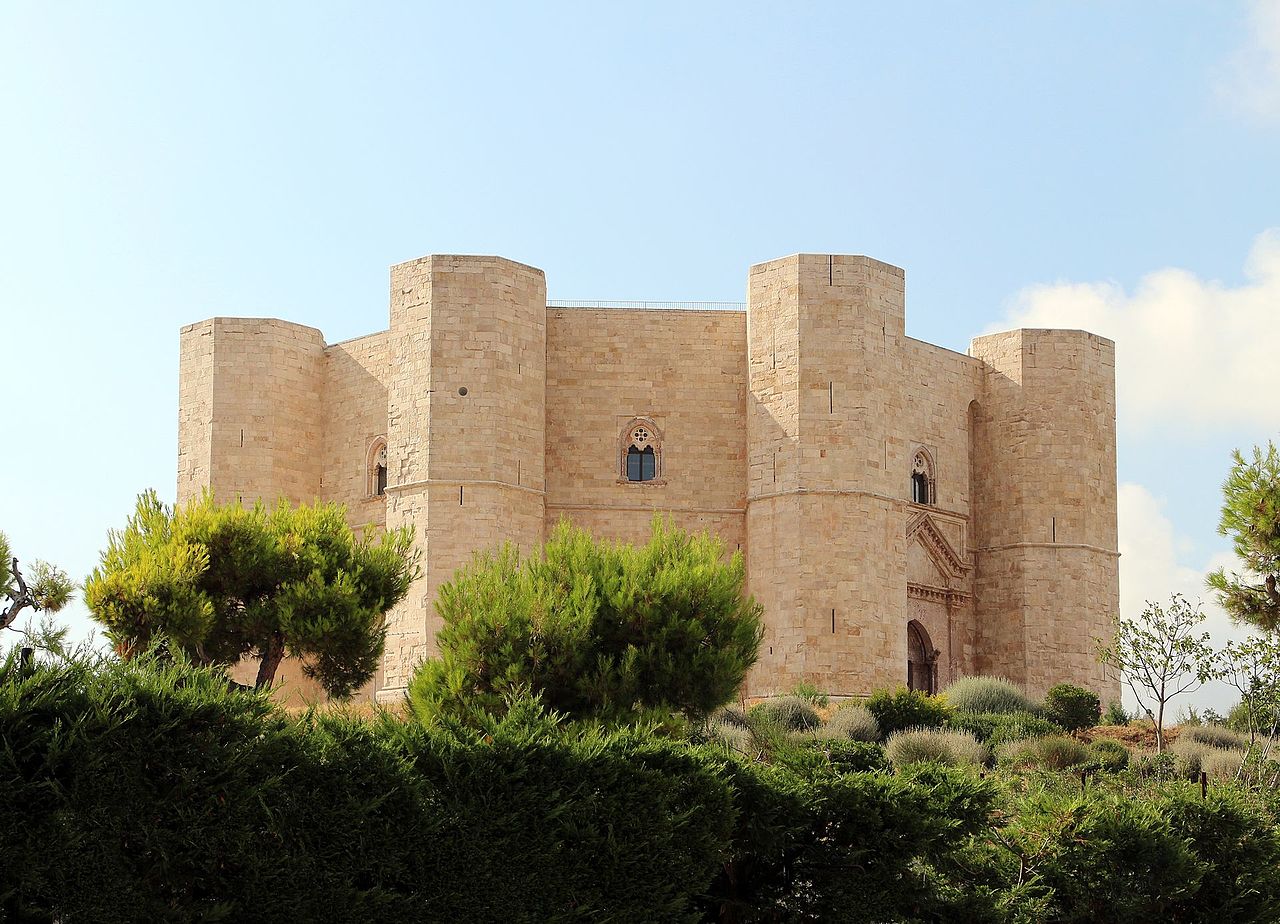 |
| Castel del Monte. Ph. Credit Francesco Bini |
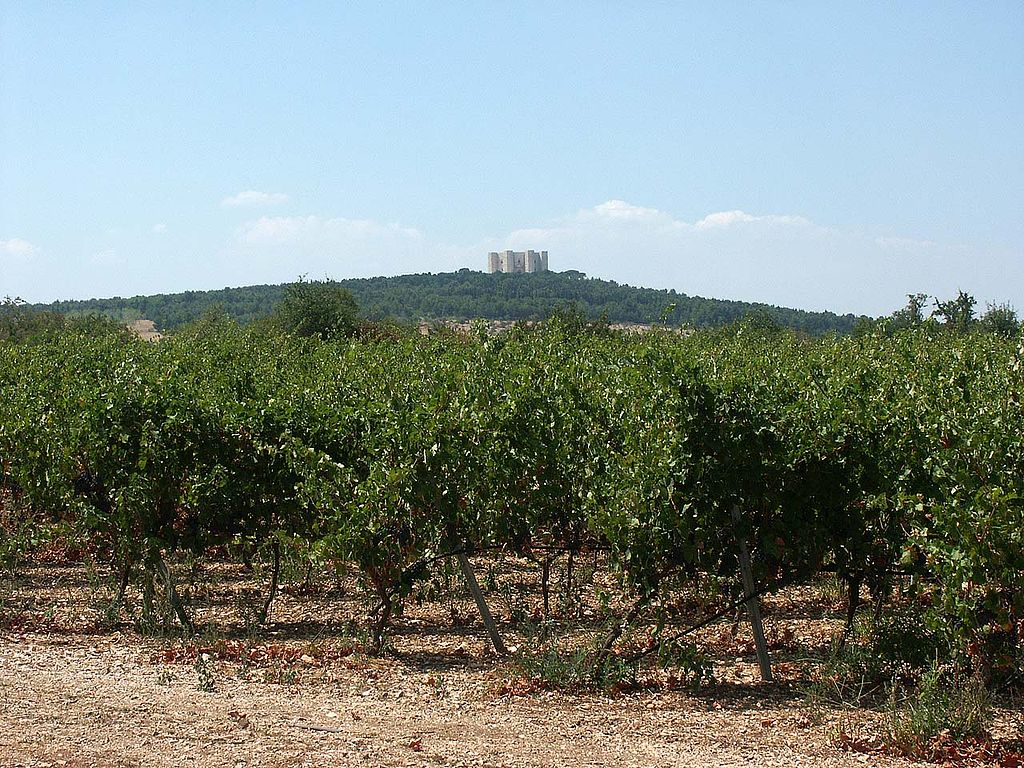 |
| Castel del Monte from a distance on the top of the hill |
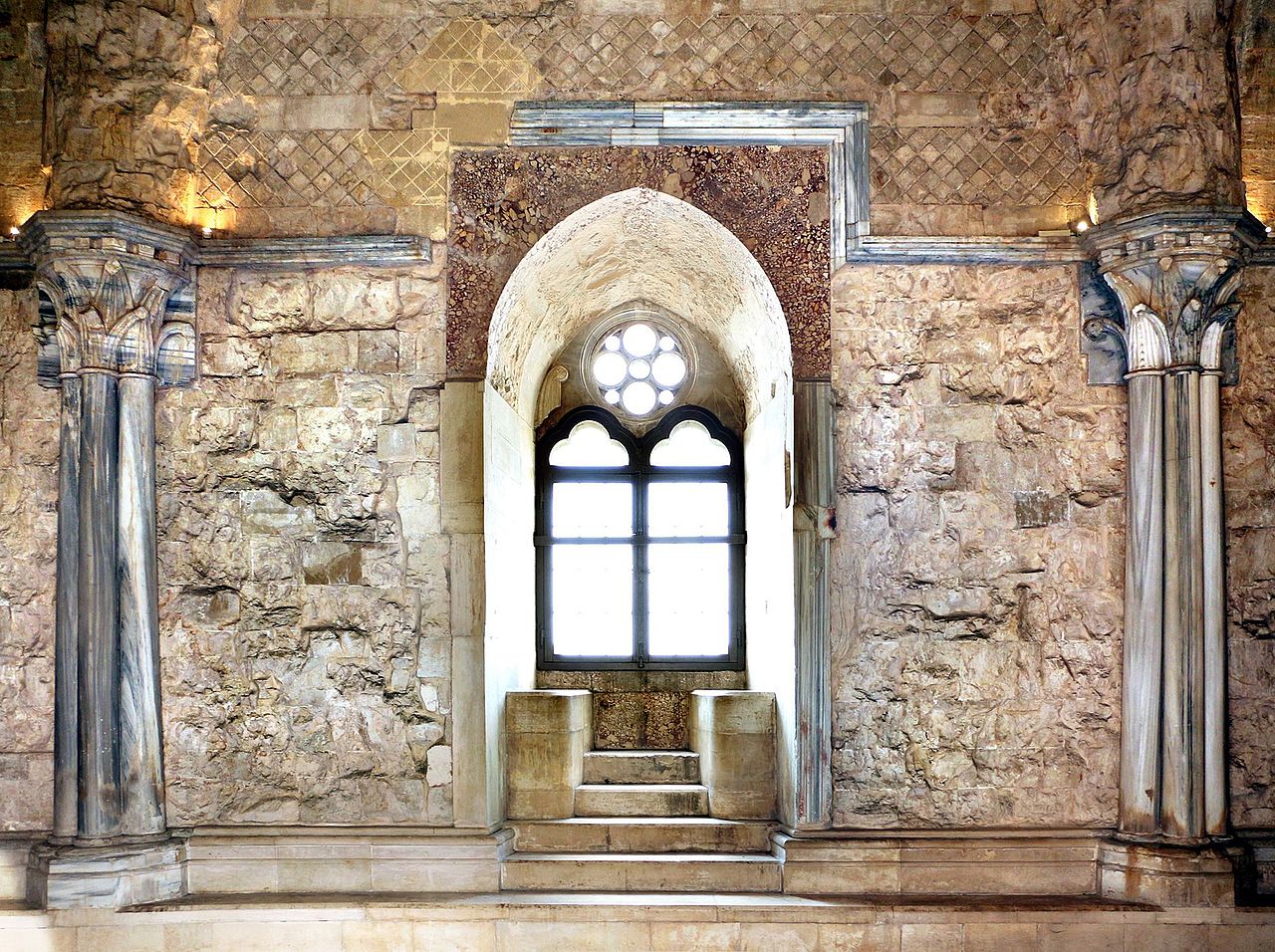 |
| Hall inside Castel del Monte. Ph. Credit Francesco Bini |
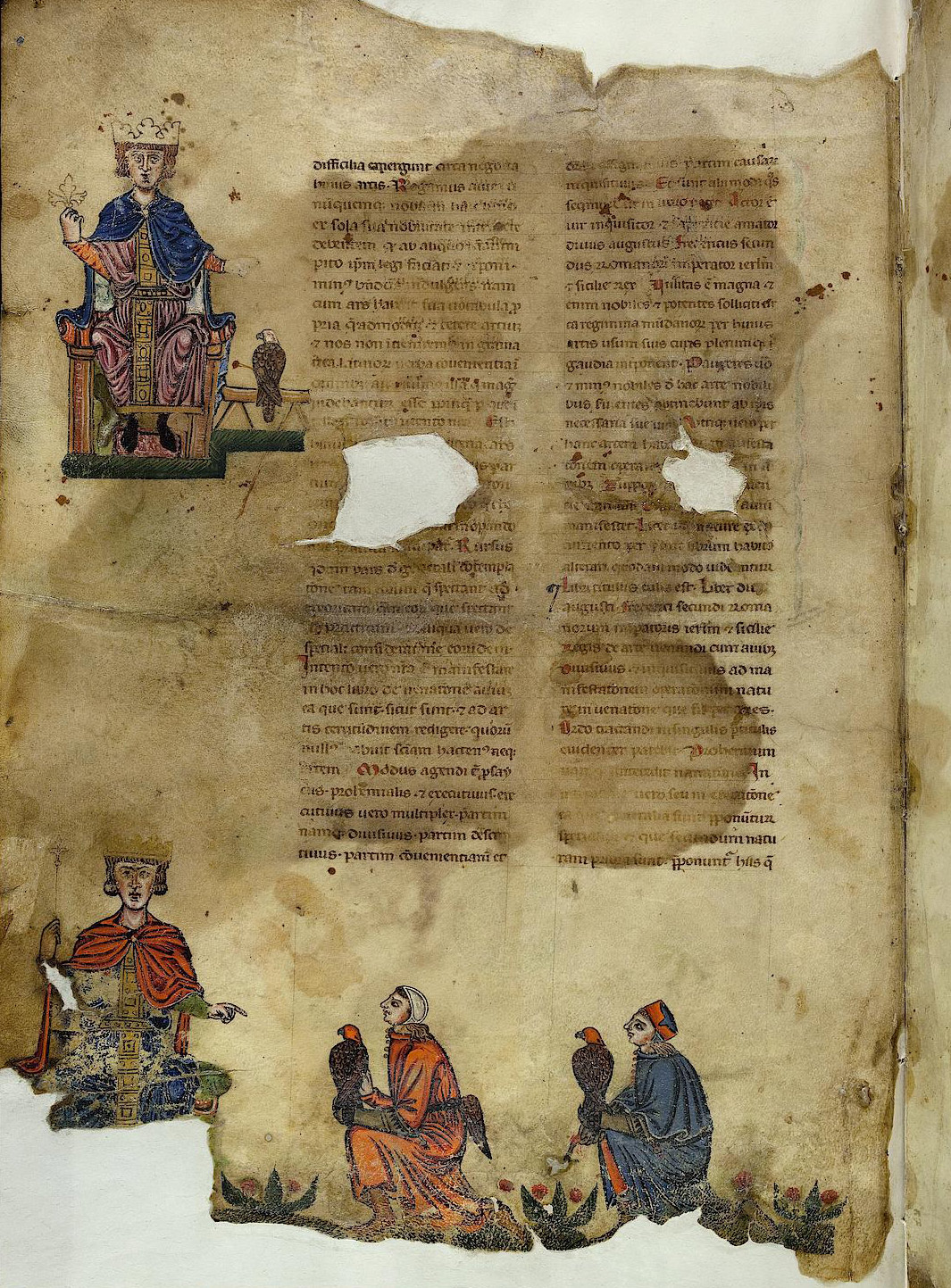 |
| Anonymous illuminator, Portraits of Frederick II and Manfred, from the manuscript of Frederick II's De Arte venandi cum avibus (c. 1260; illuminated manuscript on parchment, ms. Pal. Lat. 1071, fol. 1r; Vatican City, Vatican Library) |
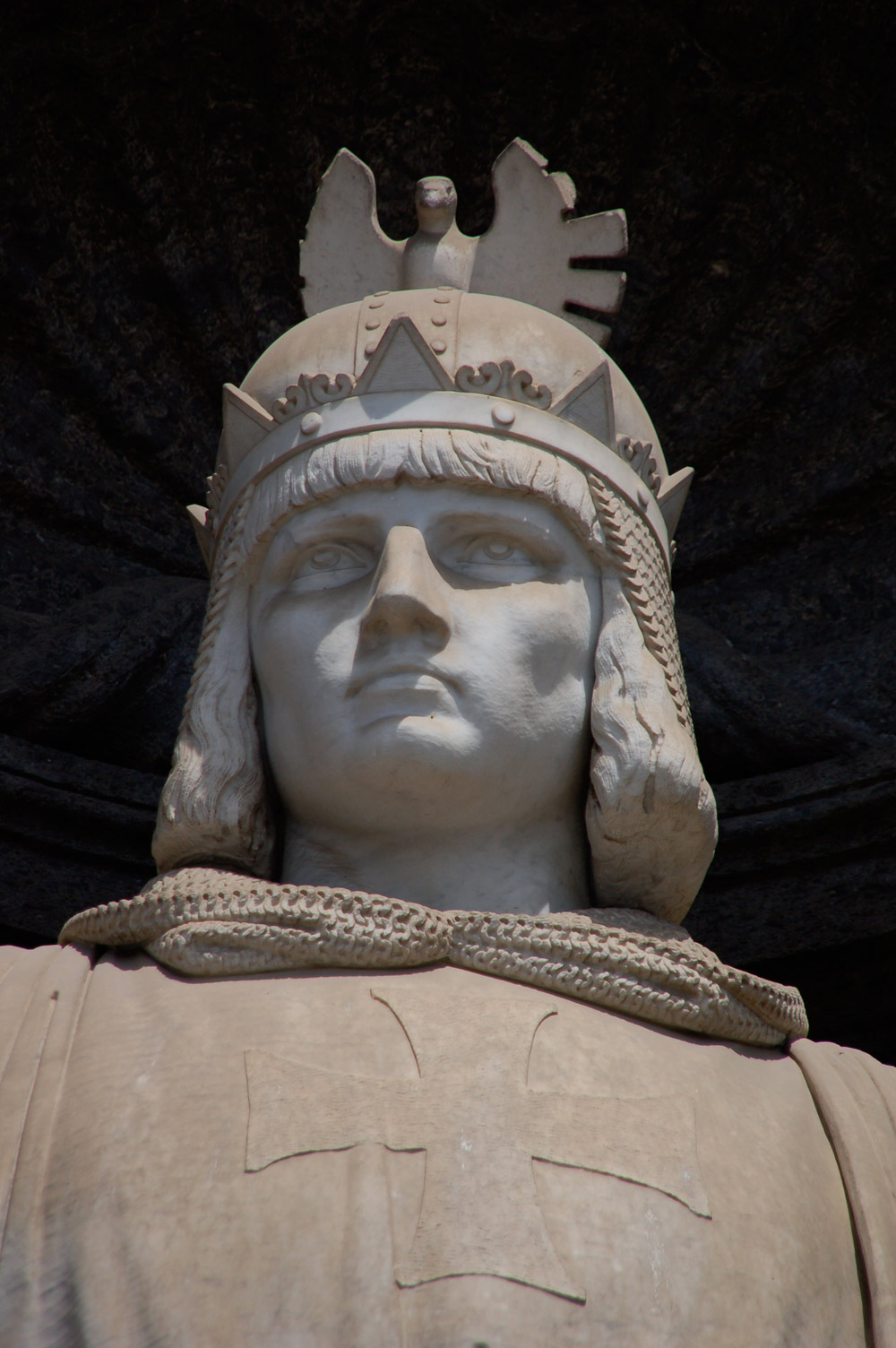 |
| Emanuele Caggiano, Statue of Frederick II, detail (1887; marble; Naples, Royal Palace) |
Where, then, do the most bizarre hypotheses about Castel del Monte come from? Obviously, playing into the hands of the strangest interpretations is the shape of the castle. Built with limestone ashlars above a rocky knoll, Castel del Monte has a massive octagonal shape: on each corner stands a tower, also octagonal, and we find the same shape in the inner courtyard, where columns and portals are made of coral breccia, a reddish-colored stone that creates a remarkable contrast with the white colors of the limestone. Finally, in the past the castle must have had several white marble decorations, which only partially survive today. There are two floors of the castle, each consisting of eight rooms (thus totaling sixteen) of trapezoidal shape, covered with ribbed cross vaults in the central square, with the columns also made of coral breccia, and ogival barrel vaults in the corner spaces (an interesting fact is that the keystones are all different). To ascend from one floor to another, the designers inserted spiral staircases, with steps that are also trapezoidal, built into three of the eight towers (the others are for practical purposes: cisterns for rainwater, bathrooms and toilets, which was rather unusual for the time but is also found in other Frederician castles, and soldiers' quarters). The upper floor is also distinguished by the presence of mullioned windows (as well as a triple lancet window) and slimmer vaults, all of which make the rooms on the upper floor more elegant than those on the lower floor. The entrance consists of a large gabled portal, preceded by two symmetrical flights of stairs.
It is not certain that the choice of the octagon does not bear a symbolic character, but in any case, in the case, it would have nothing to do with strange esoteric rites or obscure astral symbology: there are those who have linked the shape to a solar symbolism, still others have considered to see in the octagon a reference to the halo symbol of sanctity, while some scholars have related the shape of the castle to that of the imperial crown, a theory that at the moment seems to be the most probable (the crown of the Holy Roman Empire, now preserved in theHofburg in Vienna, is indeed octagonal in shape). It should be specified, however, that it is not possible to establish with certainty what the meaning of the octagon was: we cannot even rule out that Castel del Monte wanted to break free from the more traditional square shape typical of other fortresses, or was simply a personal preference of the emperor. One detail that might rule out rash interpretations, however, is the fact that Castel del Monte is not the only octagonal building of the period: in fact, there are other precedents. The most illustrious is the Palatine Chapel in Aachen: it was built at the end of the eighth century, and in turn echoed earlier octagonal buildings (such as the basilica of San Vitale in Ravenna or that of San Lorenzo in Milan), and Frederick II knew it well since he was crowned there in 1215. There are also octagonal towers of Islamic origin (such as the Torre dell'Alcázar in Jerez de la Frontera, built by the Arabs in the 12th century, or the coeval Torre de Espantaperros in Badajoz, Extremadura), but also octagonal castles built in the Hohenstaufen fiefdoms, although none is as well preserved as Castel del Monte: the examples of the castle of Hugstein, near Guebwiller, and that of Eguisheim, both in Alsace (and both in ruins), are worth mentioning. We then know that the destroyed Imperial Palace of Frederick II, which was located in Lucera, had an octagonal inner courtyard. The octagon was a polygon with which the Swabians and Frederick Ii showed a certain confidence: however, the fact that the choice was also adopted elsewhere should lead one to discard meanings that fit the context of Castel del Monte alone and, if any significance is to be found to the choice of the octagon, it is, if anything, necessary to refer it to the cult of the emperor's personality (as is well known, many of his contemporaries identified Frederick II, on the basis of a tradition that referred to Roman emperors, with the sol invictus, the "unconquered sun" whose cult was introduced in Rome in the era of the late empire, and whose figure was associated with several emperors, Constantine above all).
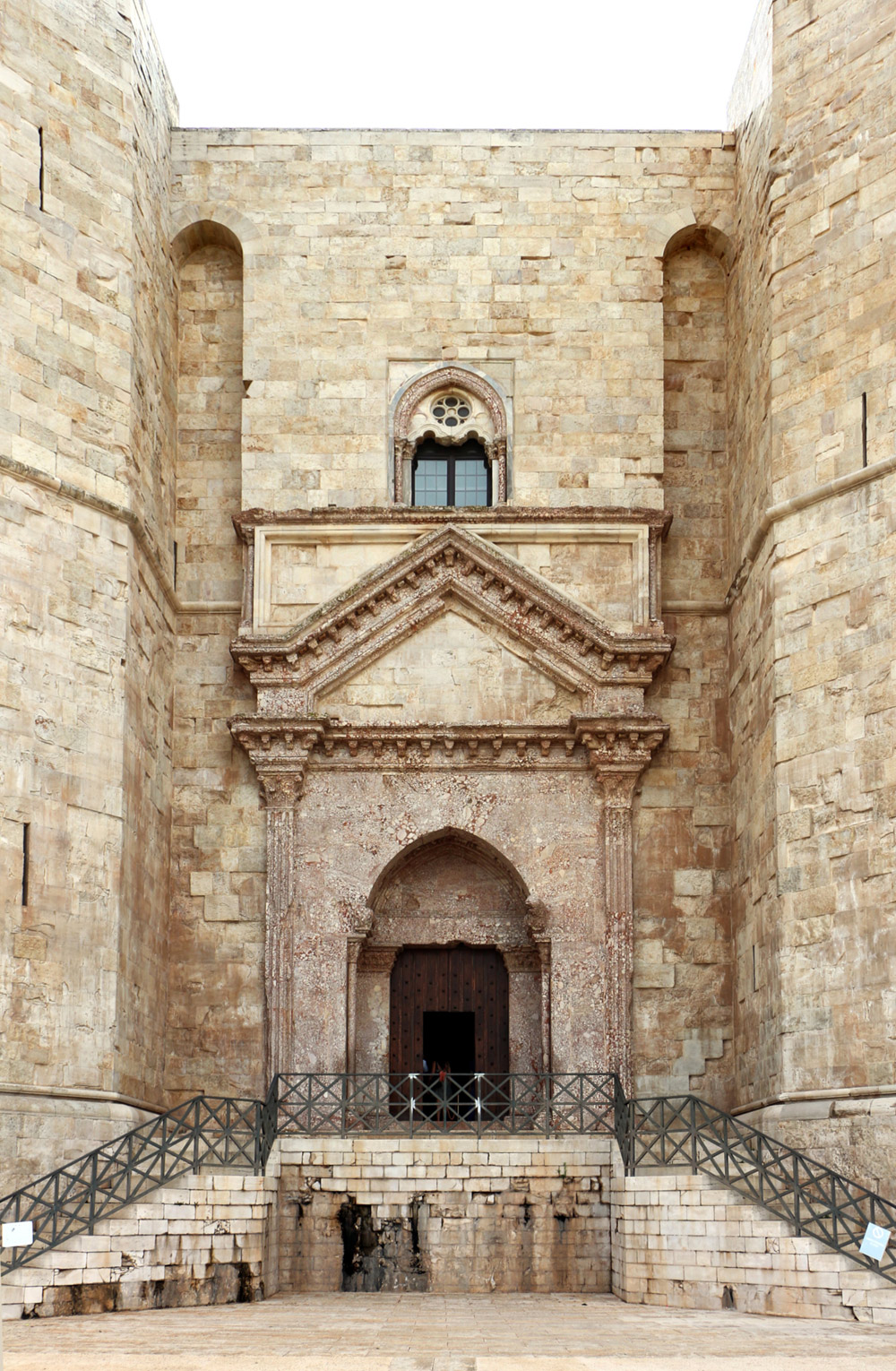 |
| The entrance portal of Castel del Monte. Ph. Credit Francesco Bini |
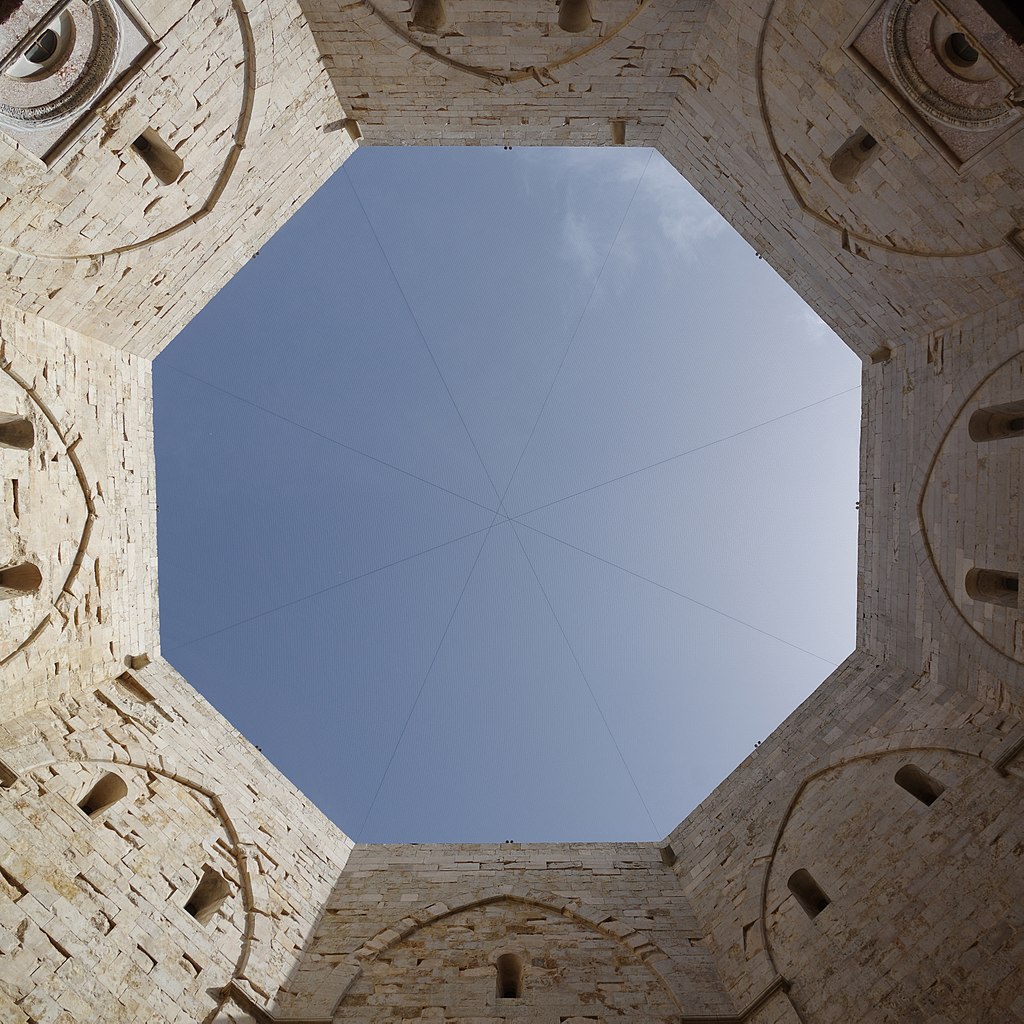 |
| The octagon of the courtyard from below. Ph. Credit Francesco Bini |
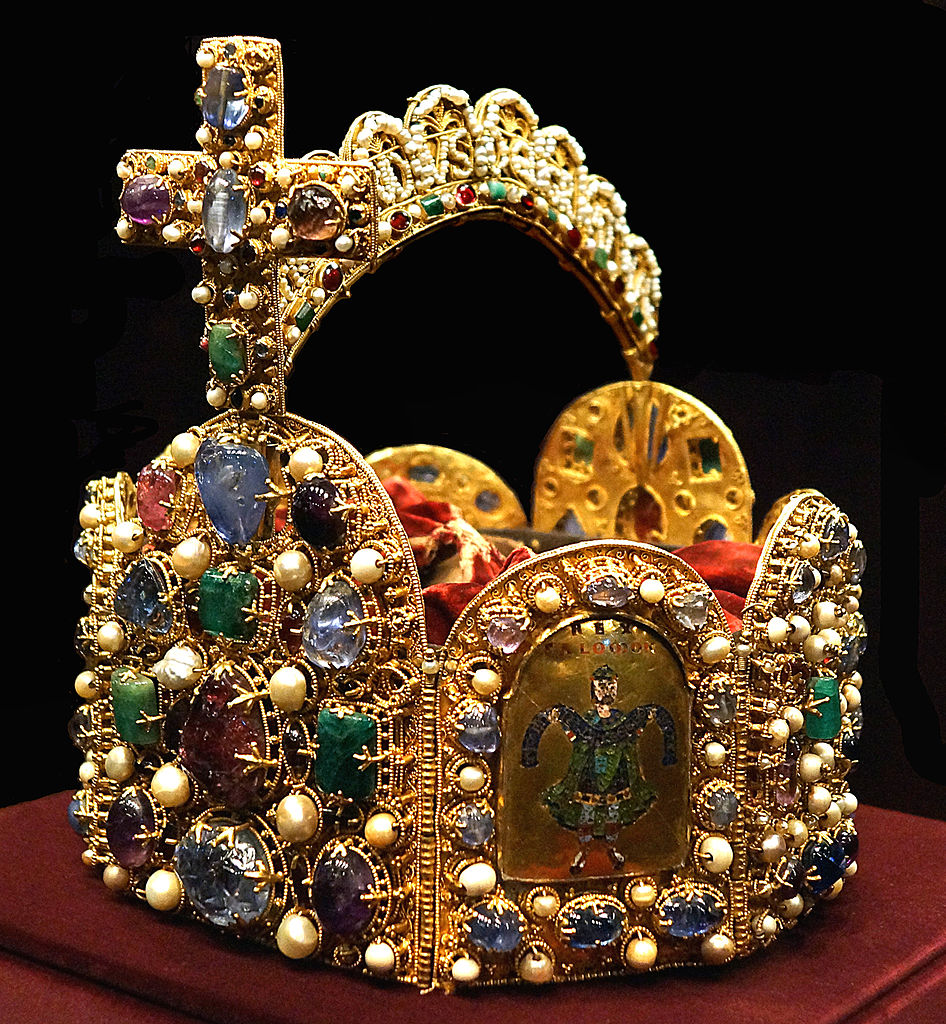 |
| German goldsmith, Crown of the Holy Roman Empire (2nd half of 10th century, early 11th century cross; gold, cloisonné enamel, pearls, precious stones; Vienna, Kunsthistorisches Museum) |
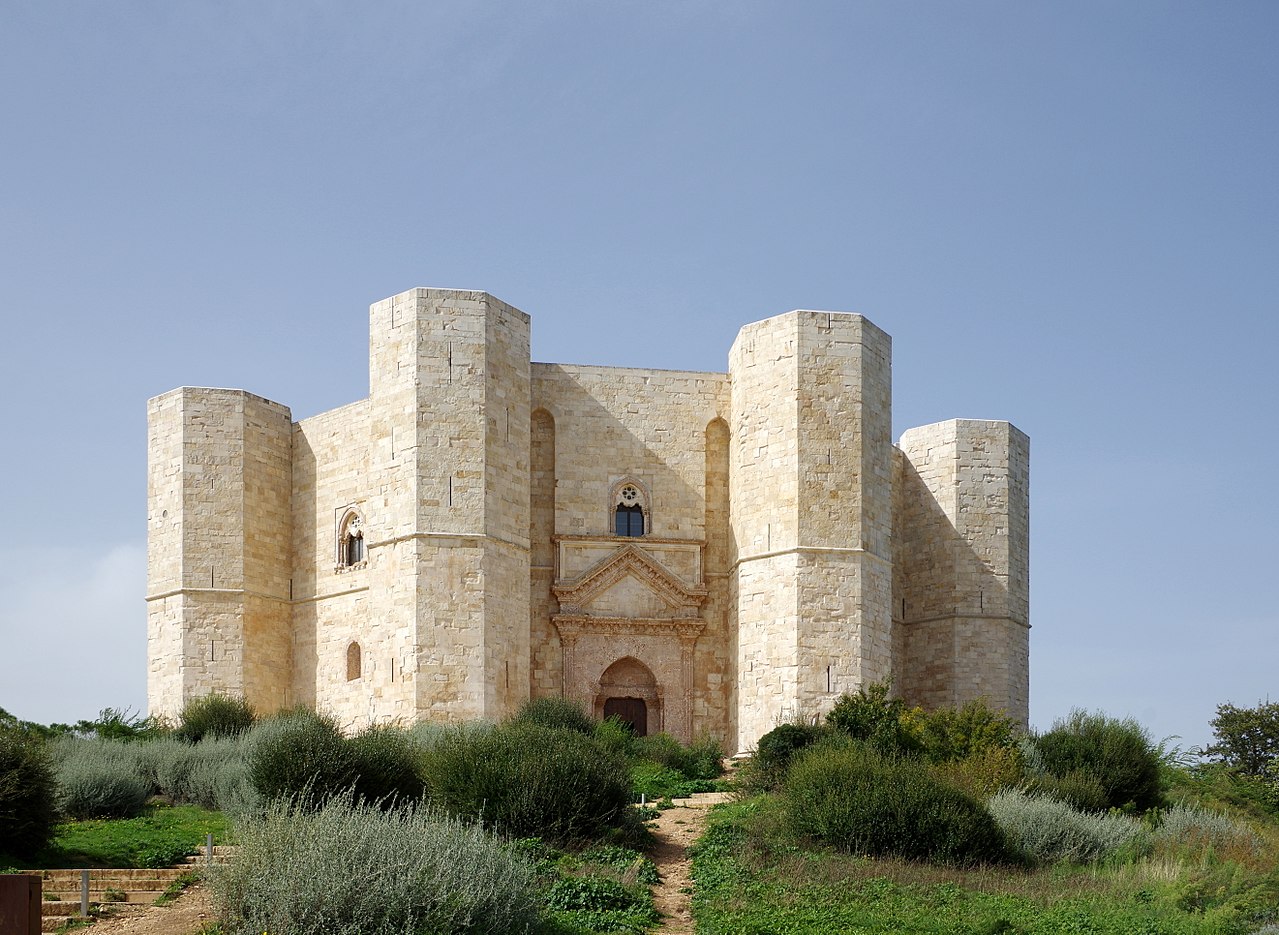 |
| Castel del Monte. Ph. Credit Berthold Werner |
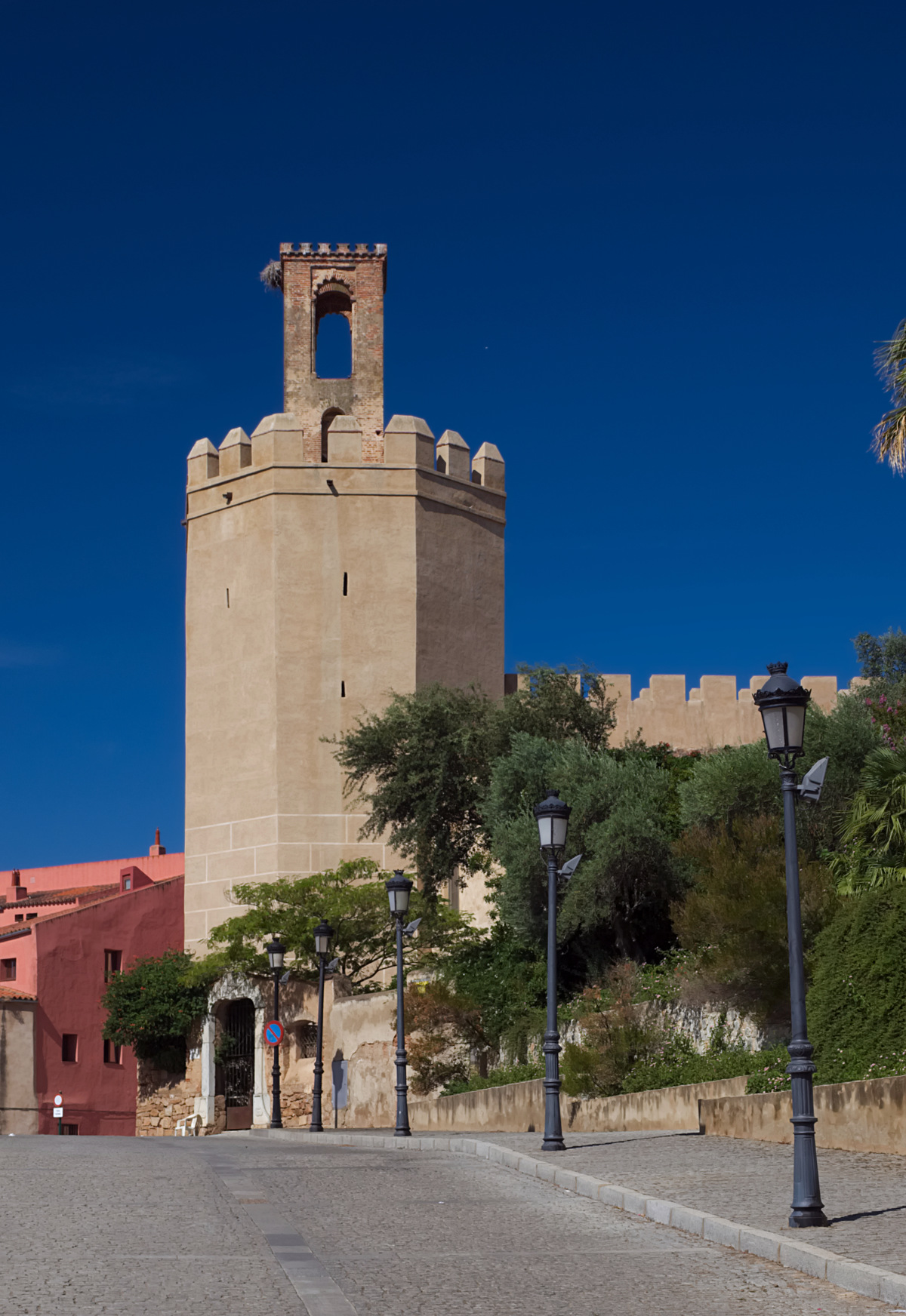 |
| Torre de Espantaperros in Badajoz. Ph. Credit Jose Mario Pires |
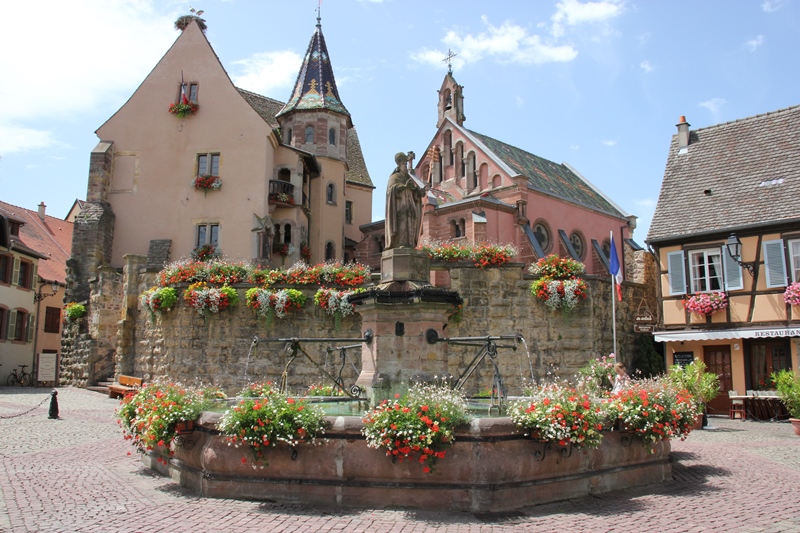 |
| The remains of the castle of Eguisheim. Ph. Credit Alsace Tourist Board |
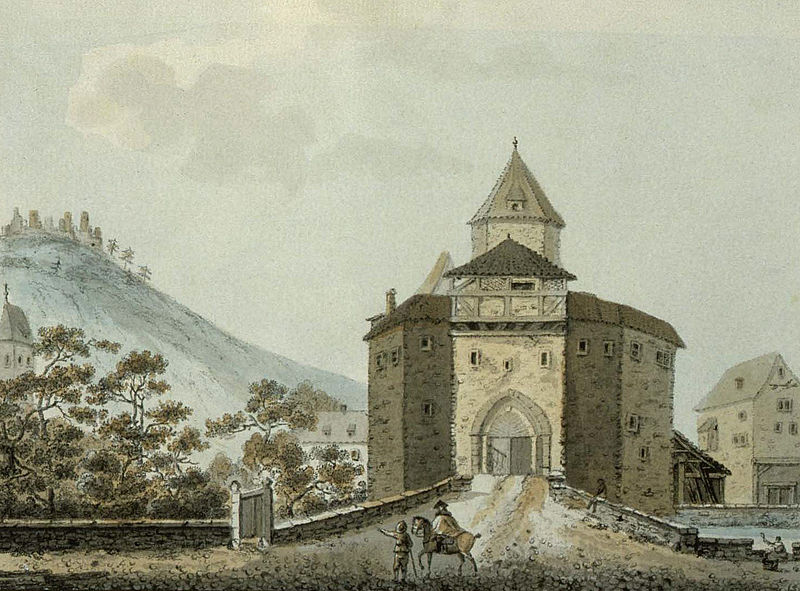 |
| François Walter, The Castle of Eguisheim, from Les images d'Alsace (1785; Strasbourg, Bibliothèque Nationale et Universitaire) |
It should be specified that today Castel del Monte, although it is the only Frederician castle to have come down to us whole and with an appearance similar to the original one, looks very different from how it must have turned out in the eyes of an observer of Frederick II's time. For example, we know that in all probability the castle must have had battlements. But not only that: certainly, it appeared much more decorated than how we see it today (decorations were one of the most important elements of Castel del Monte, a sign that it must not only have been a military fortress, but also a residence or a seat of representation). "The purpose of that gigantic shaped hard stone," wrote scholar Joshua Musca, "was not only to allow Frederick short or not-so-short pauses cheered by the sweets and comforts of living as a Roman emperor or eastern despot, it was not only to grant him and his companions and guests seated in the window wells of the upper floor the view of a vast horizon, of a conspicuous slice of imperial lands, but also (and above all) to 'be seen' from afar: a building with high semantic potential that emanated, more than soothing aesthetic charges, effective and deep emotional charges." "Functional needs" and "symbolic values," in Castel del Monte, thus proceeded hand in hand, and the building appears, "more than any other Frederician construction," Musca further asserted, "the portrait of the imperial secular state, a portrait proclaiming power and security, the 'petrification' of an ideology of power, a manifesto of kingship entrusted to time in materials less perishable than parchment. It was a particularly eloquent message for the 'readers' of the 13th century, who were very sensitive to visual language, but it was also an instrument of ostentation and intimidation. In Frederick's time, power propagandized itself with a language interwoven with theatricality, made up of processions, ceremonies, ritual gestures, insignia, banners, robes, and helmets, but also constructions of scenographic impact on the observer." Hence not only the demands of grandeur and majesty that the castle still evokes on those who see it nowadays (even from afar!), but also the need to decorate it in the most fitting manner, with marble in profusion and a widespread decor of sculptures.
Of all the sculptural apparatus that once adorned the castle, however, little remains today. In the courtyard the fragment of an equestrian figure survives, part of an iconographic program that made use of human figures assumed "in an architectural function (corbels and still keystones), to achieve the presentation of the image in its immediacy and historical concreteness" (so Maria Stella Calò Mariani), as in the case of the knight inserted in a niche in the courtyard. Of the statue, probably an equestrian portrait of Frederick II himself (a confirmation would come from the fact that it is surmounted by a canopy with a cusped vault: a typical element of the statues of saints and emperors in Gothic cathedrals in France and Germany, which moreover could also support the hypothesis of an execution to be attributed to a master of Nordic origin), very little remains: part of the bust (the figure wears a chlamys), an arm, a hint of a leg, fragments of the head. Very little, but enough to derive the classical impression. It is then necessary to point out a sculpture of great importance, preserved, however, at the Pinacoteca "Corrado Giaquinto" in Bari: this is a laureate head found in 1928 in an excavation at Castel del Monte and since then also called the "Molajoli fragment" because the first to study it was art historian Bruno Molajoli. Nothing is left of this head from the eyes down, but again the little that can be seen (the locks of hair, the laurel branches, the wrinkles in the forehead, the very hollowed eye sockets) gives reason for the importance of the sculpture, which has been related by many to some of the masterpieces of Frederician sculpture, including the headless portrait of the emperor that adorned the gate of Capua. In addition, the character's expressiveness (guessable from the eyes) and realistic facial features have again suggested that it is a work of transmontane culture. We do not know who the subject portrayed but it had to be an official portrait (however idealized), and we certainly know that laureate heads were adopted in imperial numismatics from 1231. Also preserved at the Bari museum is a fragmentary emperor bust found at Castel del Monte in 1897, also probably to be attributed to a sculptor from the Germanic area. It has been noted, however, that the Classical ascendancy of this bust is much attenuated: "the Classical model," wrote Luisa Derosa in the work's official entry in the Pinacoteca's catalog, "lives in this sculpture only in its most obvious iconographic valences. The stylistic-formal rendering, when compared directly with ancient sculpture, is far from those sources. Beginning with the knot of the cloak, tied on the left shoulder to form a loop that leaves uncovered a large part of the tunic underneath, to the profile of the sharp and sharp neckline. Such elements, in contrast to the classical tradition, as has been repeatedly stated by critics, find if anything greater points of contact with early Christian sculpture."
If little is left of the sculptures, the discourse changes for the decorations of the structure: we can still admire the richness of the capitals and the keystones, which allow us to understand the culture of the sculptors who worked in the Frederician sphere. "The extraordinary sculptural set of Castel del Monte," Calò Mariani wrote, "opens up perspectives of European scope. To the plastic of Reims and the Sainte-Chapelle lead the plants inspired by the real of nature that adorn keystones and capitals. The very high lesson of the Franco-Rhine Gothic can be grasped in the figured sculptures, not only in the keystones and shelf-heads, but also in the fragment of a laureate head now in the Pinacoteca Provinciale in Bari. The relationship of Frederick's plastic to the ancient, which at Capua responds to a clear ideological intent, at Castel del Monte and Lagopesole flexes into a freer language of fresh Gothic meaning. In the architecture of Castel del Monte, the legacy of antiquity is echoed in the solemn intonation that the tympanum gives to the portal, in the windows on the courtyard, girded with laurel wreaths and necklaces of ovoli and fusarole, in theopus reticulatum that guilloche the walls of some of the rooms on the upper floor; but with greater evidence it shows itself in the sculptural parts: see the headless bust and the fragmentary head crowned with laurel." The keystones of the rooms are adorned with fig or sunflower leaves, acanthus whorls, vine or ivy shoots, mulberry fruits (often, moreover, the leaves are eight in number, in accordance with the castle's key-number) and almost contribute to the creation of a botany manual, nor are there any lack of fantastic animals or anthropomorphic masks. On the capitals, on the other hand, faces, telamons and acanthus leaves abound, according to a great variety typical of the sculpture of the time. On the corbels of the portal there are then, as in many Romanesque and Gothic buildings, corbels with lions: in the case of Castel del Monte, the lions are executed in coral breccia.
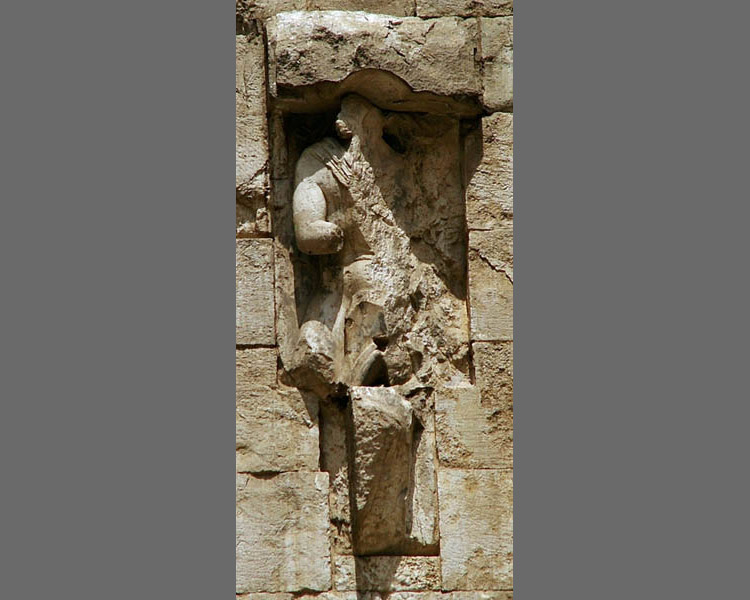 |
| Unknown sculptor, Equestrian figure (1242-1246; limestone; Andria, Castel del Monte) |
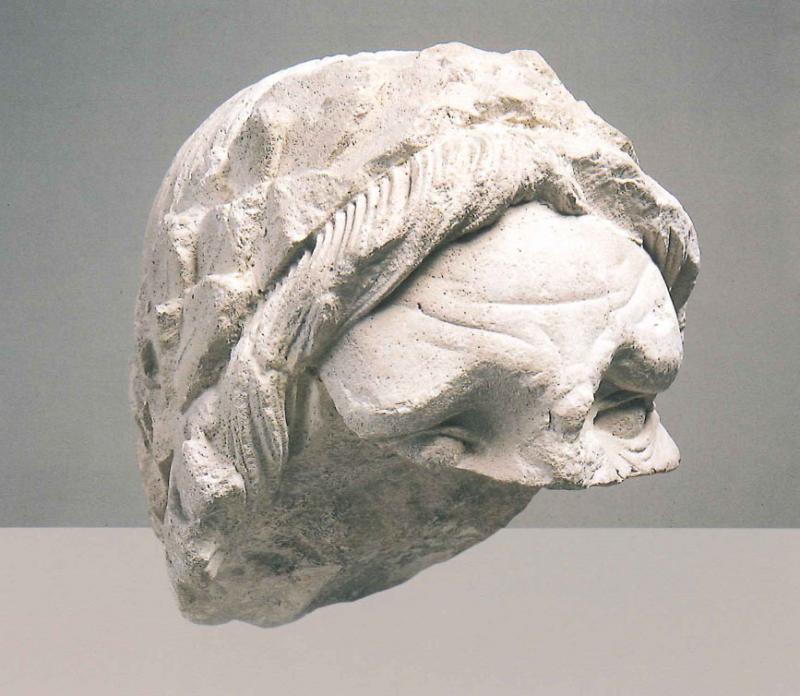 |
| Unknown sculptor, Graduated head also known as Molajoli Fragment (13th century; limestone, 27 x 24 x 30 cm; Bari, Pinacoteca Corrado Giaquinto) |
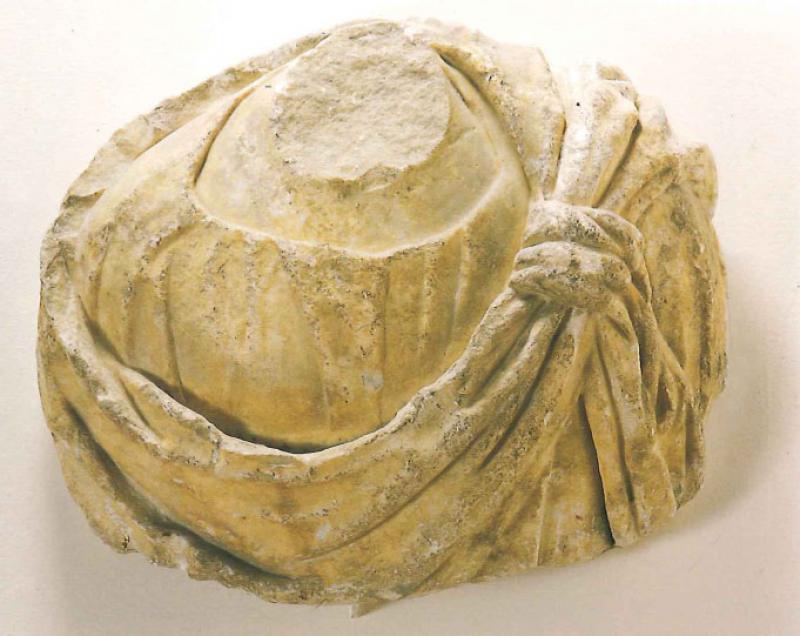 |
| Unknown sculptor, Bust of emperor (13th century; marble, 40 x 48 x 16 cm; Bari, Pinacoteca Corrado Giaquinto) |
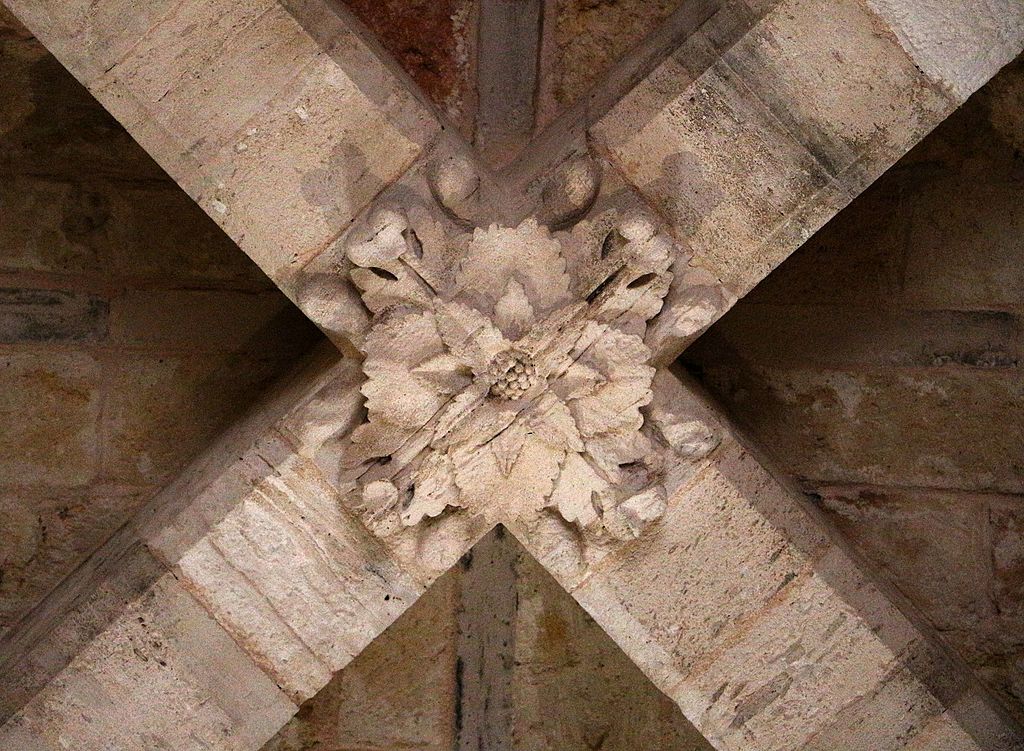 |
| Keystone. Ph. Credit Francesco Bini |
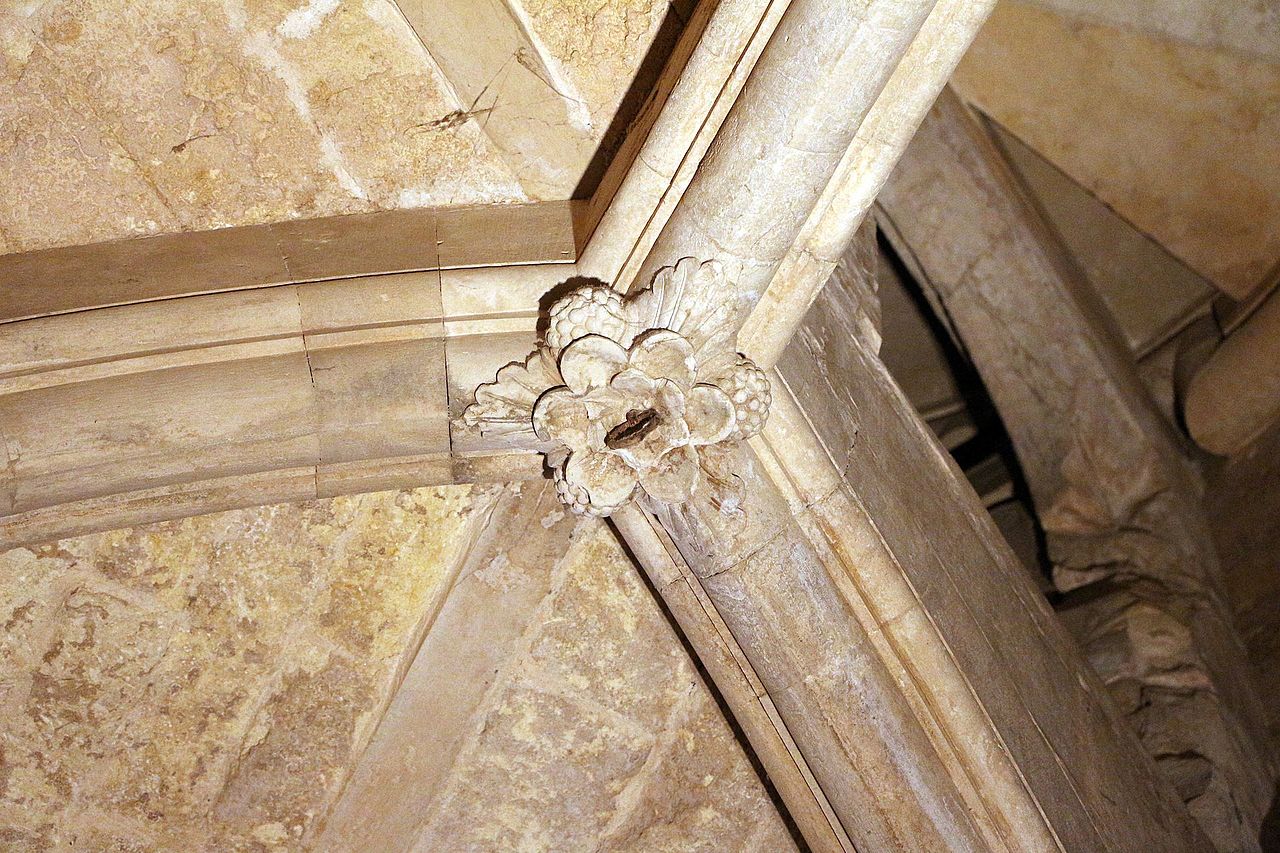 |
| Keystone. Ph. Credit Francesco Bini |
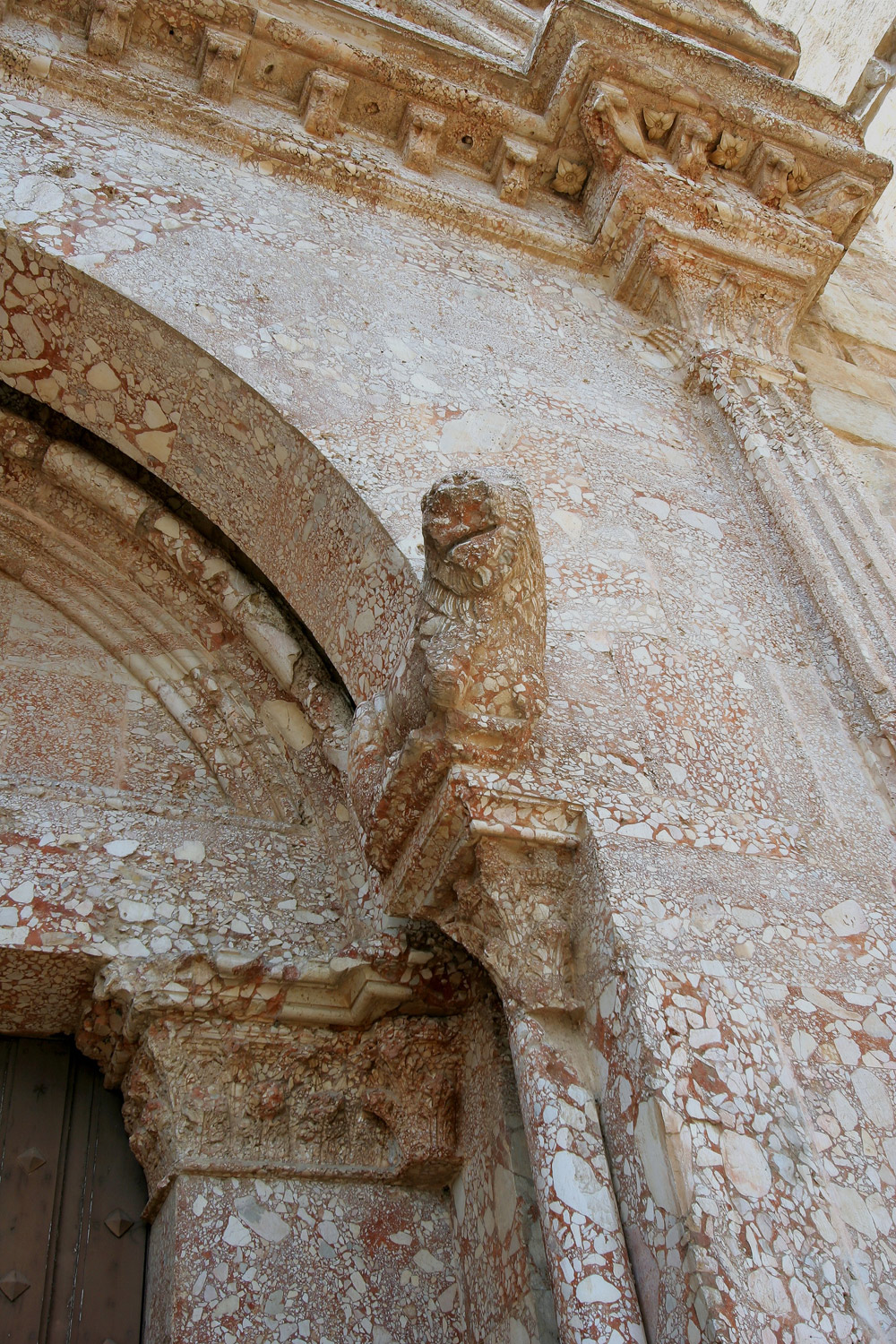 |
| Portal lion. Ph. Credit Francesco Bini |
Castel del Monte continued to be used as a fortress for a long time: it was also the scene, in 1528, of a battle between French forces, led by Odet de Foix, and the imperial army, as part of the War of the League of Cognac. On that occasion, Castel del Monte, used for defensive purposes to prevent the French advance towards Naples, was bombed and heavily damaged. The castle's fate changed further in 1552, when the duke of Andria, Gonzalo II Fernández de Córdoba, who held the property, ceded it to Fabrizio Carafa, count of Ruvo, who made it a place of pleasure residence. The castle remained the property of the Carafa family for a long time, and in 1686 it was still to retain much of its decoration: dating from that year is a letter from Abbot Giovanni Battista Pacichelli in which Castel del Monte as a building "vaghissimo dentro," provided with "ornaments from outside that make that body majestic," a "nobilissimo atrio, e confacevole ad un magnifico palazzo, e ben munito castello, con le porte di puro, e fine metallo": the abbot then described some sculptures that are not preserved today. It was during the eighteenth century that Castel del Monte experienced a period of neglect, during which most of the spoliation took place, causing the removal of almost all of the building's decorative apparatus, and during which the castle became a destination and refuge for peasants, shepherds and brigands.
The state of decay in which Castel del Monte was in the early 19th century is well attested by an eloquent print by Victor Baltard (Paris, 1805 - 1874), made as part of a massive study of the Swabian and Norman castles of southern Italy commissioned, practically out of sheer passion, by Honoré-Théodoric-Paul-Joseph d'Albert, eighth duke of Luynes (Paris, 1802 - Rome, 1867), to a very young Jean-Luis Alphonse Huillard-Bréholles (Paris, 1817 - 1871), historian, who was to take care of the texts, and precisely to Baltard who was to do the drawings. Published in Paris in 1844 under the title Recherches sur le monuments et l'histoire des Normands et de la maison de Souabe dans l'Italie méridionale, the study was 172 pages long and was accompanied by 35 illustrations (Baltard's name, moreover, was suggested to the Duke of Luynes by Jean-Auguste-Dominique Ingres, who at the time was director of the Académie de France in Rome, at which the young architect was studying at the time). Huillard-Bréholles wrote that "the marble of the walls and the white stone of the benches have been stripped for fragments, and these rooms are in a deplorable state of decay, but the columns and windows are sufficient to testify to the ancient splendor." It is clear in the drawing what the state was: the castle was partially ruined, the towers in ruins, vegetation taking over the building. The turning point came only in 1876, when the Carafa family, who were still the owners of the castle, sold it to the Italian state for 25,000 liras: the contract stipulated between the parties states that Castel del Monte was now a ruin ("being that the age-old castle in question, yes it is an artistic historical monument, is however unsuitable and absolutely incapable of any use, both for its present state and for the nature of its constructions and for the solitary and uninhabited place in which it is located"). Moreover, as is evident from the photos of the time, the exterior masonry was heavily weathered and ruined.
Then began a long season of restoration, which began in 1879. During the first phase, directed by engineer Francesco Sarlo and continued until 1885, the structure was consolidated to prevent collapse, the roofs were waterproofed, and the window frames (which had been removed in the meantime) were added. Sarlo's intervention was not without subsequent criticism, because ex novo additions made with stone from a nearby quarry (which was believed to be where the original materials had come from) were also carried out. Work was halted for forty years due to lack of funds, and only resumed in 1928, with restoration directed by Quintino Quagliati and Gino Chierici. The objective of the intervention was to restore Castel del Monte to a condition similar to what it must have been in the thirteenth century, and for this reason the restorations of the 1920s also sparked controversy, since the work of integration with new material continued, worked in a manner similar to the original (albeit in a balanced manner: the need was still to consolidate the structure, however, and the insertion of new elements was seen as urgent to achieve this goal). One of the main critics was the restorer Carlo Ceschi (Alba, 1904 - Rome, 1973), who directed harsh considerations toward the first phase of the work (the restorations of 1879-1885 were, according to him, "conducted with so little artistic sensitivity that even today, almost sixty years later, they create a sense of unease even in the visitor least accustomed to judging on the subject"): it was Ceschi, moreover, who was appointed to continue the work in 1933, as soon as he became superintendent (his interventions were mainly conservative in nature). The present appearance of Castel del Monte is due to the restorations of the 1960s, conducted by Francesco Schettini, Renato Chiurazzi and Riccardo Mola: Castel del Monte was considerably "rejuvenated," and the way the works were conducted attracted new criticism. Even with the "new" appearance, however, the problems had not stopped, so much so that between 1975 and 1981 a new restoration, directed by Giambattista Detommasi, became necessary to consolidate the curtain walls, which are still subject to constant maintenance as they are subject to sudden deterioration.
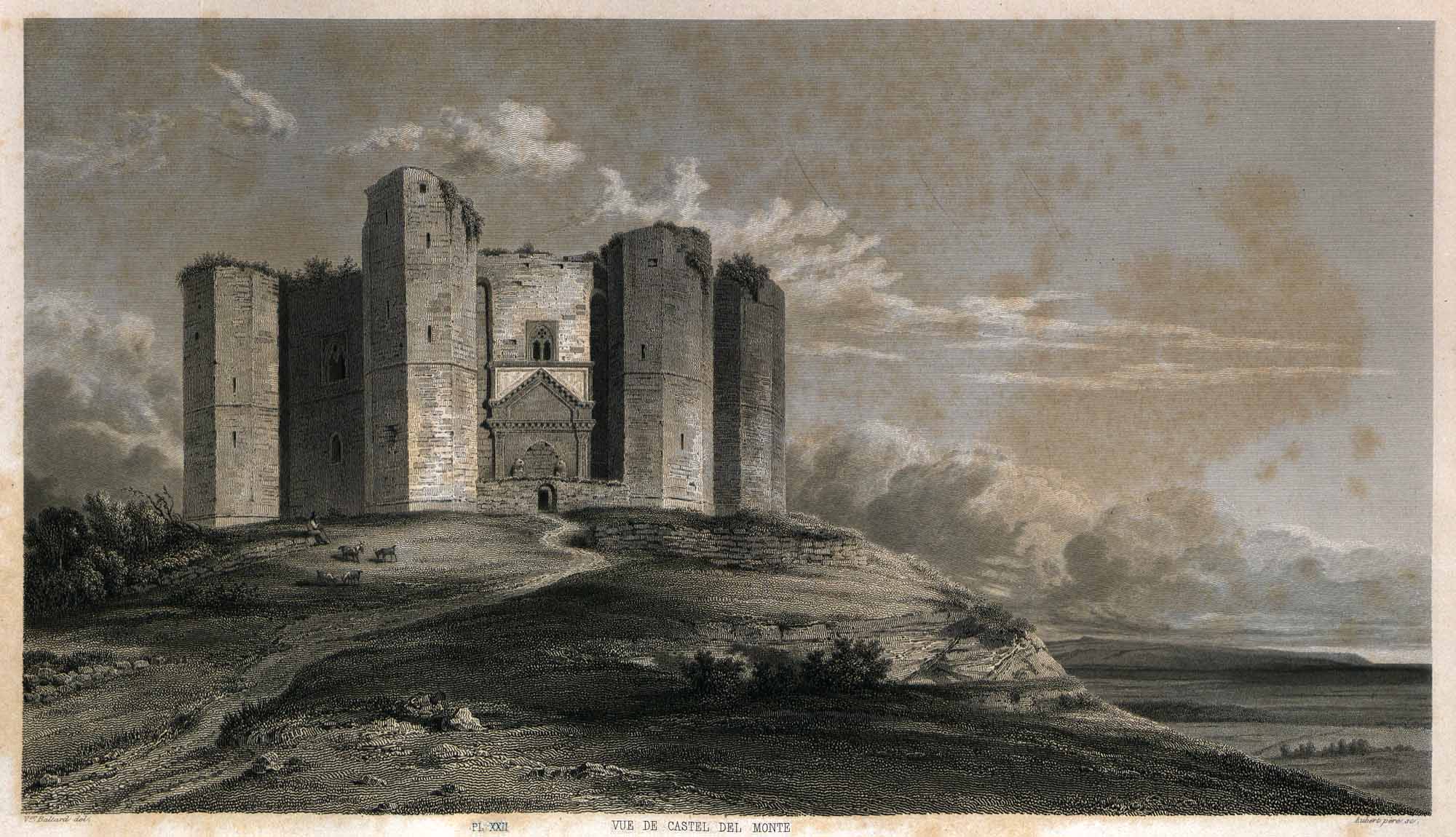 |
| Victor Baltard, Castel del Monte, from Jean-Luis Alphonse Huillard-Bréholles and Victor Baltard, Recherches sur le monuments et l'histoire des Normands et de la maison de Souabe dans l'Italie méridionale, Paris, Imprimerie De C.L.F. Panckoucke, 1844 |
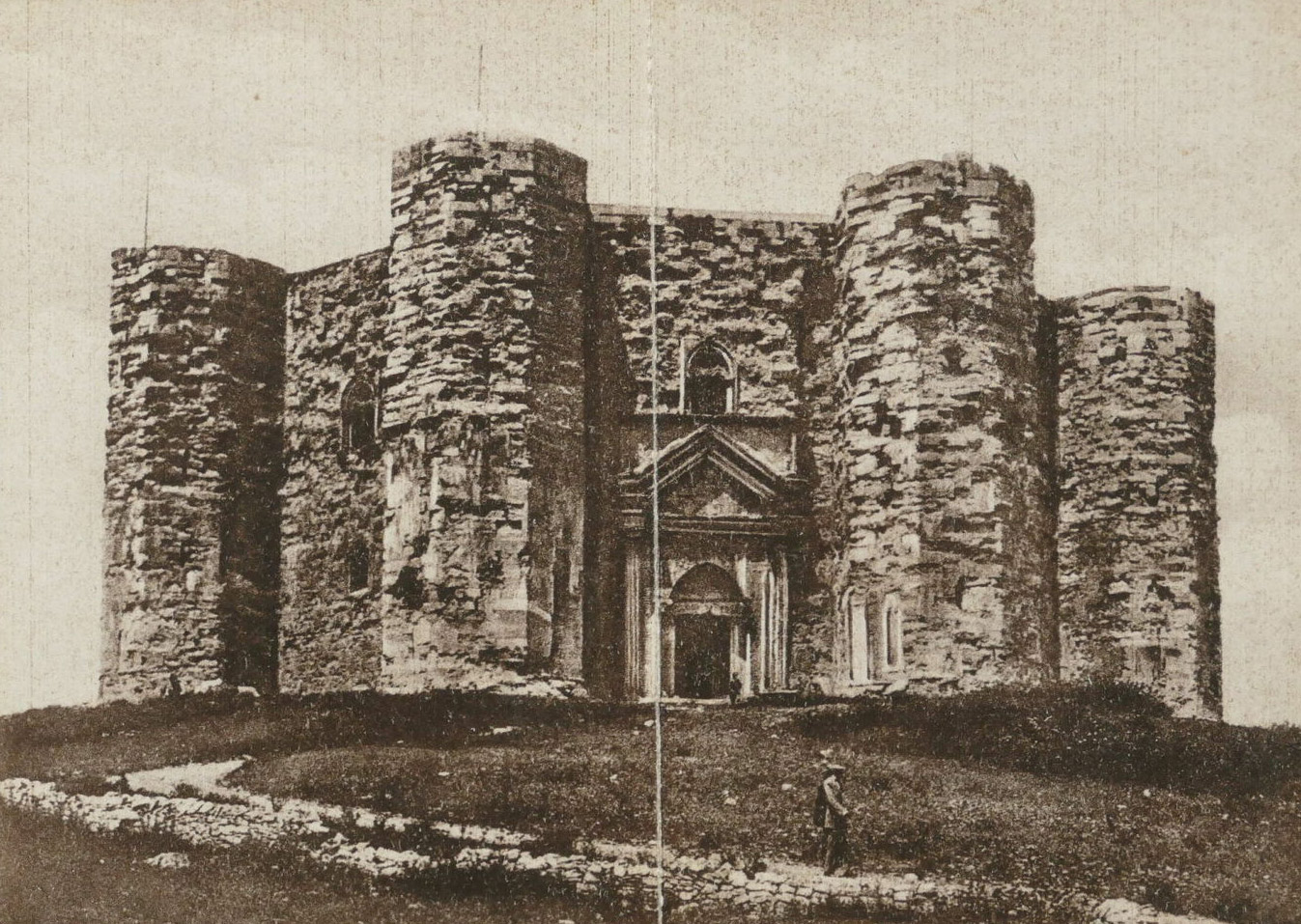 |
| Castel del Monte in a postcard from the 1920s. |
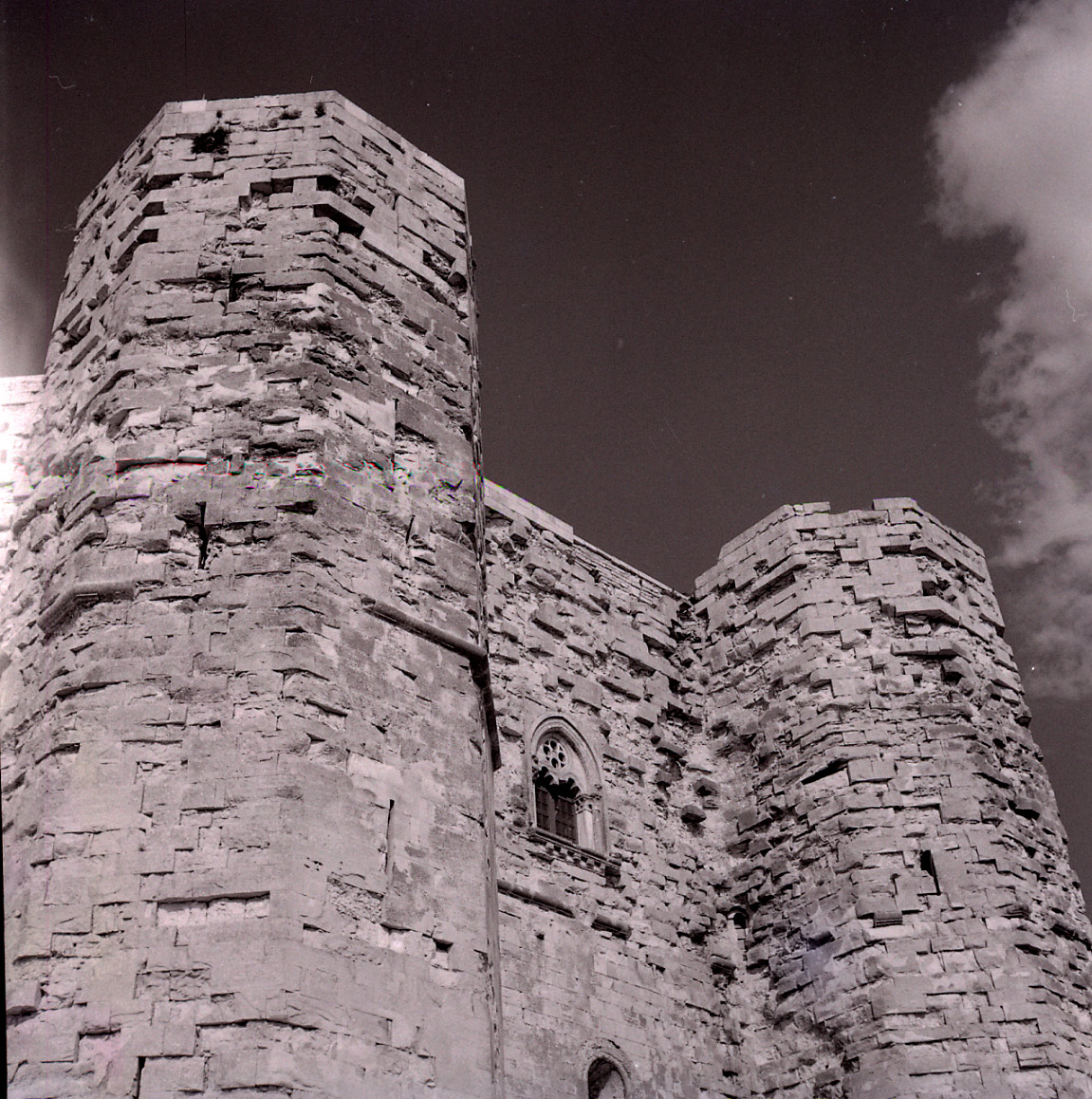 |
| Castel del Monte in 1959. Photo by Paolo Monti |
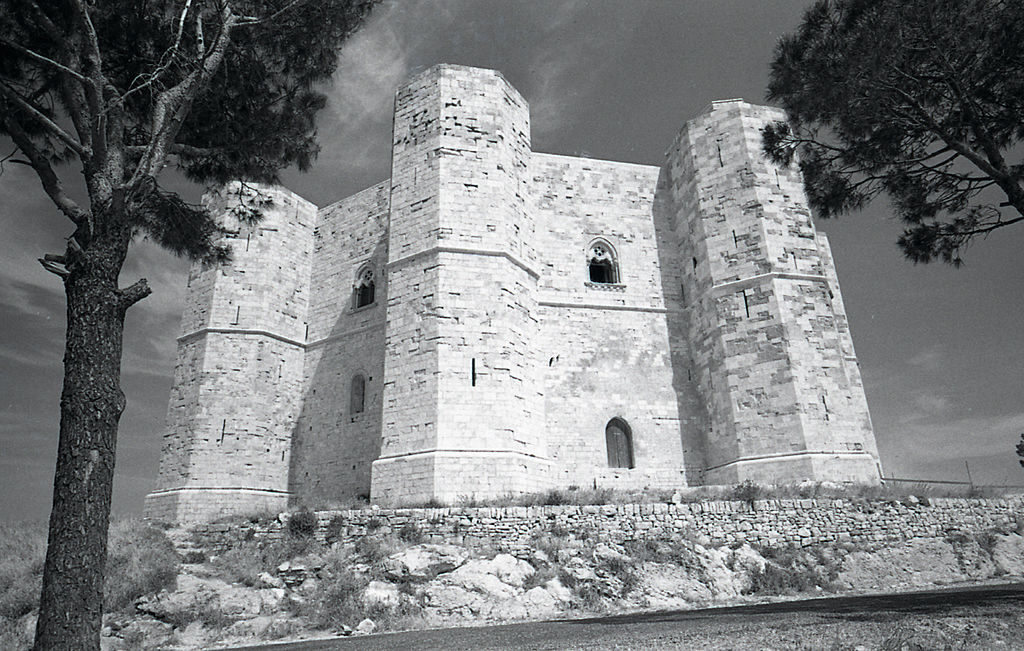 |
| Castel del Monte in 1965. Photo by Paolo Monti |
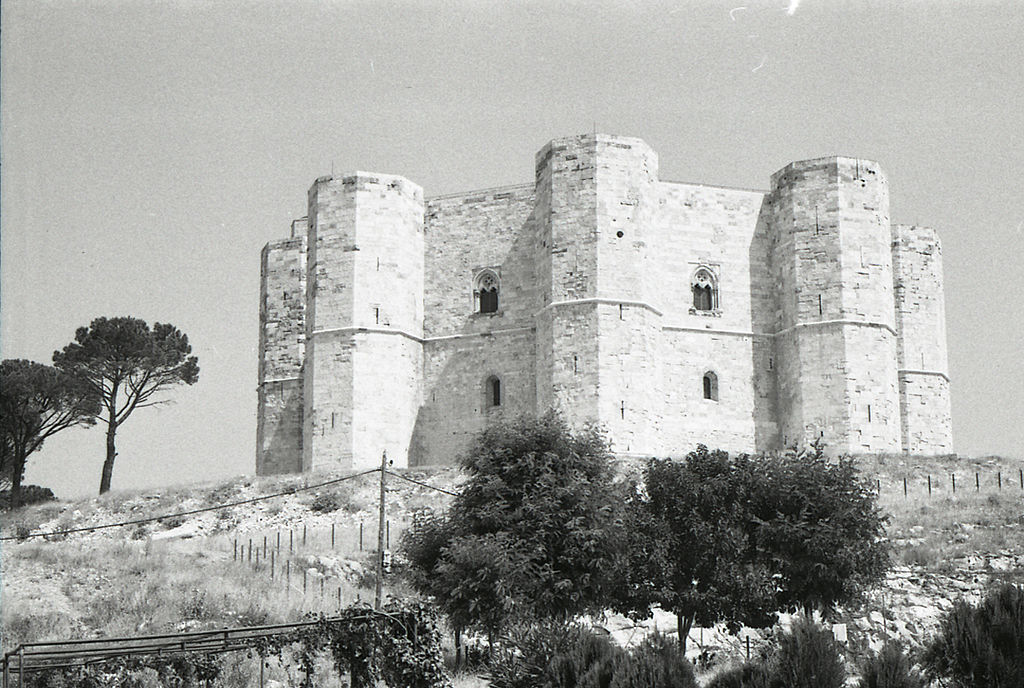 |
| Castel del Monte in 1970. Photo by Paolo Monti |
Since 1996, Castel del Monte has been part of the UNESCO World Heritage Site, included with this reason: "When Emperor Frederick II built this castle near Bari in the thirteenth century, he imbued it with symbolic meanings that are reflected in the location, the mathematical and astronomical precision of the structure and the perfectly regular shape. A unique example of medieval military architecture, Castel del Monte is a virtuoso blend of elements from classical antiquity, the Islamic East and the Gothic of Cistercian Europe." Today, it can be asserted without much doubt, Castel del Monte is one of the main icons of the national cultural heritage, so much so that it was chosen to appear on one of Italy's euro coins (the one cent coin), it is a place that has inspired books and films, as well as fueled, as we have seen, the liveliest fantasies about what was done inside it during the time of Frederick II, although, as historian Franco Cardini has rightly written, "the only possible hypothesis about Castel del Monte is that it is, indeed, a castle."
One of the best and most refined descriptions ever produced on Castel del Monte remains that of Cesare Brandi's Pellegrino di Puglia, who saw it before the restorations of the 1960s spoke of it in these terms: "the building, unkempt and poorly maintained inside as well as outside, nevertheless has an arrogance of its own that is difficult to resist. And yes, of all Apulia, this is not the monument to which my preferences go, although the most distinguished, after the San Nicola. But really, as in its plan of a geometric regularity that makes one think more of snow crystals than the work of man, there is a secret meeting of different civilizations, in which each sings in its own language, yet the polyphony is perfect. One wanted French, and not that French architectural civilization in some part is not there, but it was a long way from France to Apulia: many things changed on the way, and already so much had changed with the Normans, who were far more French than Federigo II. In Federigo's court everything was mixed, and in Castel del Monte everything was mixed as well. Actually, even the Umayadian castles do not come equal to join Castel del Monte. The Umayadian castles were still the Roman desert farm, exalted to a palace by the new rich, and with the water speck right where there was no water. Here in Castel del Monte, it is not that there was no more water than in the desert, but the good architects of Arab descent who took care of the water systems did a masterpiece. [...] I would swear that Federigo II must not have loved Gothic architecture at all: what there is of Gothic, in Castel del Monte, are barely the vaults and ribs; but not the windows, which are still those Arab ones that bejeweled the Norman buildings of Sicily. And then, the firm walls, the taste of the wide surfaces, still Byzantine or Romanesque, would be enough, if we really don't want to say Arab: and instead we have to say it, because if there is anything that makes Castel del Monte think of, it is of the Fatimite gate of Cairo, it is of the high windowless walls that envelop the Mosque of Ibn Touloun. [...] Finally, the corrective of classical antiquity: that portal surmounted by the tympanum, where, of course, the classical proportions evaporate, but acquire an exquisitely novel accent, and, in that accent preserve the classical etymon. Whence in the golden augustals, Federigo, wearing a chlamys and redeemed with laurel, makes it as a Roman emperor."
Reference Bibliography
- Maximilian Ambruoso, Castel del Monte.
- La storia e il mito, Edipuglia, 2018
- Elisabetta Scungio, Huillard-Bréholles e lo studio dei monumenti della Puglia normanna e sveva in Arte medievale, IV, VIII (2018), pp. 217-228
- Giuseppe Fallacara, Ubaldo Occhinegro, Micaela Pignatelli, Storia dei restauri a Castel del Monte in Giuseppe Fallacara, Ubaldo Occhinegro, Castel del Monte
.- Unpublished scientific investigations, conference proceedings (Bari, June 18-19, 2015), Gangemi Editore, 2015
- Massimiliano Ambruoso, Castel del Monte
.- Historical survival manual, CaratteriMobili, 2014
- Raffaele Licinio, Medieval castles
.- Apulia and Basilicata: from the Normans to Frederick II and Charles I of Anjou, CaratteriMobili, 2010
- Clara Gelao (ed.), La Pinacoteca provinciale di Bari, Istituto Poligrafico dello Stato, 2008
- Maria Stella Calò Mariani, La memoria dell'antico nell'arte pugliese del XII e XIII secolo in Arturo Carlo Quintavalle (ed.), Medioevo: il tempo degli antichi, proceedings of the conference (Parma, Sept. 24-28, 2003), Mondadori, 2006, pp. 462-476
- Raffaele Licinio (ed.), Castel del Monte
.- A medieval castle, Adda, 2002
- Raffaele Licinio (ed.), Castel del Monte and the castle system in the Apulia of Frederick II, Edizioni dal Sud, 2001
- Maria Stella Calò Mariani, L'arte del Duecento in Puglia, Istituto Bancario San Paolo Torino, 1984






























